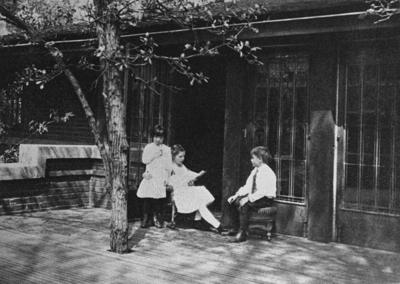Small-town Wisconsin faced a major test of its civic values 100 years ago when it confronted the crime of the century: Seven people were murdered at Taliesin, Frank Lloyd Wright’s estate, on Aug. 15, 1914. The killer used gasoline and fire to panic the residents, and the house was destroyed as victims died from blows from a shingling hatchet.
Wright’s companion, Mamah Bouton Borthwick, 45, was among those killed in the noontime attack, as were her two visiting children, John and Martha Cheney, ages 10 and 8. A 13-year-old boy, Ernest Weston, the son of Wright’s foreman, also was killed. His father, William Weston, was hurt, and so was draftsman Herbert Fritz Sr. Both survived to identify the killer, Julian Carlton, 31, an African-American chef from Chicago who had come to work at Taliesin that summer with his wife Gertrude, a maid. The Carltons had come recommended by the caterer of Wright’s new Midway Gardens project, John Vogelsang Jr., whose father ran a restaurant in the Loop.
Saturday was to have been the Carltons’ last day at Taliesin. They were to return to Chicago on an afternoon train. Wright had advertised for their replacements on Wednesday and Thursday in the Wisconsin State Journal, and then had left for Chicago to put finishing touches on Midway Gardens.
After seating the mother and her children at one end of the house and the workmen at the other and serving them lunch, Carlton went on a murderous rampage. Gertrude Carlton later said he had become agitated and paranoid in recent days, and there had been altercations with one of the draftsmen, Emil Brodelle, 26, of Milwaukee, who had ordered Carlton to saddle his horse and called him a “black son-of-a-bitch” when he refused. Brodelle’s murder was witnessed by Fritz, and that testimony became the basis of Carlton’s prosecution.
One hundred years later, Carlton’s attack seems well planned. He grouped and separated his targets, striking only after they were seated at opposite ends of the house. He went after the weakest ones first, the mother and children. He increased his power by using the element of surprise and an accelerant — gasoline — to create chaos. He had identified a hiding place — the cold furnace in the cellar. He had a fallback suicide plan — a bottle of hydrochloric acid, which he swallowed. He died eight weeks later in the Dodgeville jail without revealing a motive for his crimes.
During those weeks, small-town Wisconsin honored itself by giving Carlton due process. Sick in jail, he was arraigned in the hallway on Aug. 16. He appeared at a preliminary courtroom hearing on Aug. 27. On Sept. 30 he was granted a private meeting with Circuit Judge George Clementson of Lancaster, who explained his possible pleas and their consequences. The next day, Clementson ordered two physicians to examine him before his appearance to assure that he would be able to participate. Then he appointed a capable attorney to defend Carlton, Ernest C. Fiedler of Mineral Point. Suspecting that death was near, they all agreed on “a short postponement” before trial. Carlton died six days later, on Oct. 7.
Carlton had burned his esophagus with the acid and was starving. He was cared for in the jail by the wife of sheriff John C. Williams, whose family lived in the Cornish-style building. He perished 47 days after the murders, weighing 90 pounds. During that time Williams, who had stopped a potential lynch mob at Taliesin on Aug. 15, ordered crowds away from the jail and would not admit gawkers.
The race of the killer was prominent in area news coverage. Headlines called him a “Negro Maniac” and a “Black Beast.” The death certificates signed by Dr. Frank Nee of Ridgeway specified race itself as the cause of death. “Killed by a negro” was stated as the cause for Mamah Borthwick, Martha Cheney, and Emil Brodelle. Thomas Brunker of Ridgeway, Nee wrote, was killed by “a fracture of the skull caused by a hatchet in hands of a negro.”
Dr. Marcus Bossard of Spring Green, the other doctor who wrote death certificates, was strictly scientific: “burns on body and head and blow on skull” killed gardener David Lindblom, 38.
In the aftermath, Wright declared he would rebuild Taliesin and keep his home in Jones Valley. On Aug. 20 he published a tribute to Mamah Borthwick in the Spring Green Weekly Home News, and took the occasion to thank the community.
“No community anywhere could have received the trying circumstance of her life among you in a more high-minded way,” he wrote. “I believe at no time has anything been shown her as she moved in your midst but courtesy and sympathy.”
Mamah Borthwick echoed this impression in a letter written two years earlier to Ellen Key, the Swedish author whose feminist books she translated at Taliesin. “You will be interested, I think, to know how our attempt to do what we believed right has succeeded,” she wrote. “I can now say that we have, I believe, the entire respect of the community in which we live. I have never encountered a glance otherwise and many kind and thoughtful things have been done for us by the people around here.”
Small-town Wisconsin knew how to live and let live. When scandal-seeking Chicago reporters descended on Taliesin during its first Christmas in 1911, after it was revealed that Wright and Borthwick were living together unmarried, a photographer was wrestled to the ground by one of Wright’s men. The Dodgeville Chronicle reported what happened next:
“The act was applauded by onlookers, including village officials, and there were mutters against the ‘fresh Chicago guys,’ all indicating the state of mind in that locality with regard to this eccentric character.” 
Ron McCrea, a longtime Madison journalist and former city editor of The Capital Times, is the author of Building Taliesin: Frank Lloyd Wright’s Home of Love and Loss (Wisconsin Historical Society Press, $35).



